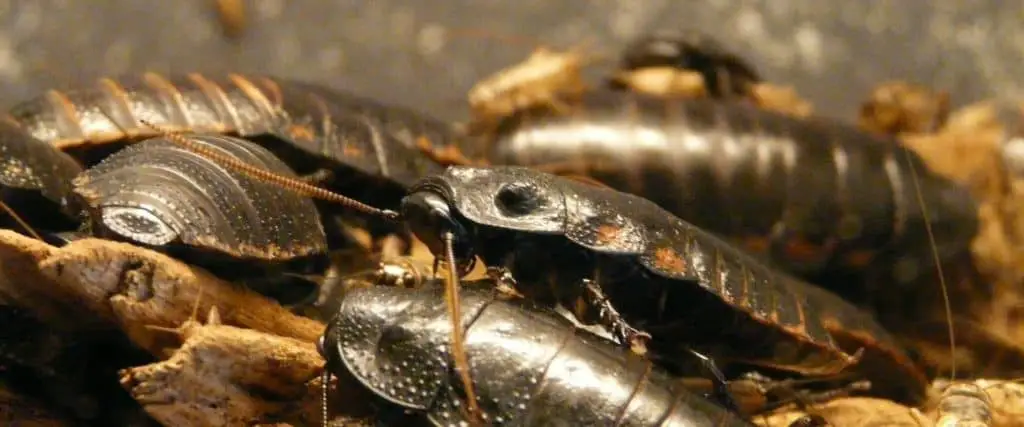Not all people like them and some even hate them: cockroaches! But did you know there are many beautiful and large cockroach species that make great pets? In fact, they are oftentimes better pets than the traditional pets like dogs and cats. Most people when they think of cockroaches they think of pests infesting your house. But only several species of the more than 4500 species total are indicated as pests species. Most cockroach species are beautiful in colour and shape, and they have very interesting behaviour. Maybe you’re going to appreciate them a little more.
There are many species of cockroaches that can be kept as pets. When keeping a cockroach colony you need to provide proper housing and a good warm climate. They can eat almost anything, but it’s best to feed them a variety of fruits and vegetables (leftovers from us). Breeding with most species is easy and you can sustain your own colony.
In this article, we will take a deep dive into the marvellous world of keeping cockroaches as pets. We will look at the most beautiful and popular species kept as pets, and we will discuss the requirements of keeping cockroaches. But first, let me explain why cockroaches make such great pets, also for kids!
Why do cockroaches make good pets?
There are many reasons to keep cockroaches as pets. When you can’t have a cat or a dog as a pet, or you don’t want to give the responsibility to your kid to take care of a pet rabbit, maybe a cockroach is a great alternative. At least, I think roaches are better pets than the more commonly kept pets. Let me explain why!
- Cockroaches don’t need much space. They can be kept in relatively small spaces;
- Cockroaches don’t eat much. You don’t have high expenses on food;
- Cockroaches don’t cost much at all. They don’t have high needs, so the costs are quite low;
- Cockroaches don’t need any veterinary care or vaccination. Easy, right?;
- Cockroaches (at least most of them) don’t make any noise. Better than a noisy bird;
- Cockroaches can’t hurt you. They don’t have mouthparts that can bite;
- When you are allergic to dog or cat hair, a cockroach can be the perfect pet for you;
- Cockroaches have beautiful shapes and colours;
- Cockroaches don’t have a long lifespan. When you don’t want to keep them anymore, you don’t have to wait for many years before it naturally dies. This is even more useful when you want your kid to give a pet animal.
Reason enough to keep a cockroach as a pet. They are amazing to keep and easy to maintain. There are many species of cockroaches you can keep. With over 4500 different species in the world, surely there will be a species that you like.
Do I need a permit to keep cockroaches? Not all cockroaches are legal to keep, and every country or state has its own regulation about keeping exotic pets. Many cockroaches are considered invasive species and are not allowed to keep. Always check the state or country regulation wether you can keep cockroaches as pets. Never release exotic cockroaches into nature. They can become pests, compete with local flora and fauna and have devestating consequences.

Suggested cockroach species that are great pets
Although there are many cockroaches, the species discussed below are the most commonly kept cockroach species and often widely available in specialized pet shops, exotic pet trades or online breeders.
We list the most important characteristics, like size, lifespan and housing recommendations. Further below, we will talk about the general care of keeping cockroaches as pets.
Madagascar Hissing Cockroach (Gromphadorhina portentosa)
See also: Keeping and care of Madagascar Hissing Cockroaches
This cockroach species is one of the most popular roaches kept as pets. With its size, colour and calm behaviour it is the perfect pet for kids and insect lovers. They are very easy to keep and are low-maintenance.
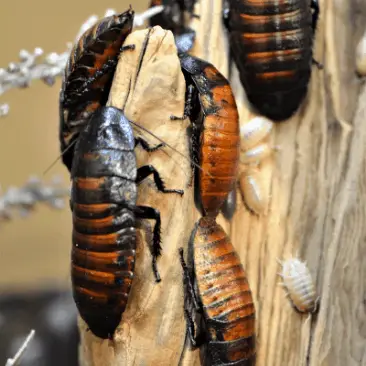
- Adult size: 65 mm
- Temperature: around 25°C (77°F)
- Air humidity: 40%-60%
- Substrate humidity: 40%-70%
- Care level: Easy
- Can it fly: No
- Can it climb smooth surfaces: Yes
Giant Burrowing Cockroach (Macropanesthia rhinoceros)
Another great cockroach species to keep as pets. These roaches are very large in size as well. Easy to keep and for cockroaches quite long-living. If you are looking for a giant, this is the species you should go for.
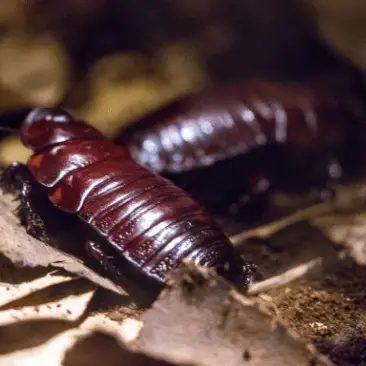
- Adult size: 80-90 mm
- Temperature: around 23°C (75°F)
- Air humidity: 40%-80%
- Substrate humidity: 60%-80% (moist)
- Care level: Medium
- Can it fly: No
- Can it climb smooth surfaces: No
Death’s Head Cockroach (Blaberus craniifer)
Besides the dubia roach in the family Blaberus this is one of the more popular cockroach species kept as pets. It is quite an easy cockroach to keep. This particular species can also be used as a feeder insect but does not reproduce as fast as the more popular dubia feeder roach.
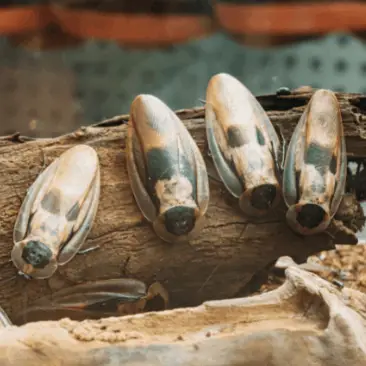
- Adult size: 55-60 mm
- Temperature: around 24°C (75°F)
- Air humidity: 40%-60%
- Substrate humidity: 40%-60%
- Care level: Easy
- Can it fly: No
- Can it climb smooth surfaces: No
Giant Cave Cockroach (Blaberus giganteus)
Although it looks very much like the death’s head cockroach, it is much bigger with sizes up to 85mm. This species is a bit more difficult to keep because of its need for a humid climate. This particular species like moist substrate to burrow in as it does in the damp caves it naturally lives.
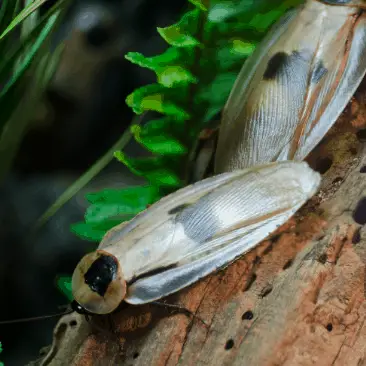
- Adult size: 75-85 mm
- Temperature: around 24°C (75°F)
- Air humidity: 60%-80% (moist)
- Substrate humidity: 60%-90% (moist)
- Care level: Medium
- Can it fly: Yes
- Can it climb: No
Domino Cockroach (Therea petiveriana)
This is quite a different type of cockroach species. It looks more like a beetle or bug. This species is quite popular mostly because of its different shape and colour pattern. It is also much smaller and can be kept in smaller enclosures.

- Adult size: 25-35 mm
- Temperature: around 25°C (77°F)
- Air humidity: 30%-50% (dry)
- Substrate humidity: 60%-70% (damp)
- Care level: Medium
- Can it fly: No
- Can it climb: Yes
Photo credits: Josh More / Flickr
Dubia Cockroach (Blaptica dubia)
Also called Guyanna Spotted Roach. Often kept as a feeder insect for other exotic bugs. Although a very good feeder, it is also a great roach to keep as a pet. This particular species is very easy to keep and great for kids as their first pet.

- Adult size: 40 mm
- Temperature: around 25°C (77°F)
- Air humidity: 40%-60%
- Substrate humidity: 40%-60%
- Care level: Easy
- Can it fly: No
- Can it climb smooth surfaces: No
Can you keep any type of cockroach as pets? In theory all cockroaches can be kept as pets. There are over 4500 cockroach species in the world (new species even discovered regurlarly). Only around 30 are considered pests species. However, not all cockroaches are available in the pet industry. Around 100 to 150 species are kept as pets, where the most popular ones are discussed in this article. If you are interested in the world of keeping cockroaches, you should definetly check out Roach Crossing. They keep, breed and sell many different species of cockroaches and provide a lot of valuable information.

How do you keep cockroaches as pets — Basic care of cockroaches
In this section, we will discuss the basic care of cockroaches in general. Although most cockroaches can be kept the same way, always check the species-specific needs for the one you (want to) keep. Research your species in more detail by checking for care guides or information about the species in the wild. Roach Crossing has a lot of information on many specific species.
Housing your cockroach colony
The first stop is the housing of your cockroaches. Housing is an important aspect of keeping your cockroaches happy but is not difficult. As mentioned before they don’t need much space. With an enclosure of 30cm x 30cm (12″ x 12″) you can keep already 4 adult cockroaches of more specimens of medium-sized cockroaches. However, keep in mind that cockroaches can reproduce fairly quickly, so larger housing can be desirable.
You can keep cockroaches in reptile terrariums of aquariums as long as they have a lid. Many cockroaches are flightless and can’t climb smooth surfaces, but keep in mind they still are escape artists. Choose a type of housing that doesn’t have holes in it where cockroaches can escape from or seal them off.
I prefer to keep cockroaches in glass aquariums with a custom made lid. Aquariums are cheaper to buy, easier to get in larger sizes and a good lid is quickly made. Plastic bins with lids can also be used to keep cockroaches, although the visibility of them is not as good as a glass aquarium. And one of the reasons you keep cockroaches is to observe their interesting behaviour, right?
Now, although you need to close off every hole and crack, your cockroaches still need ventilation. Reptile terrariums will certainly provide enough ventilation and airflow, but aquariums (with custom lid) or plastic containers do not. So you need to make some ventilation holes and cover them with fine mesh. Don’t use cloth. Remember, cockroaches eat almost anything and can quickly eat through the cloth and escape that way.
The magic starts with a good substrate. The substrate is essential for keeping cockroaches. Why? There are multiple reasons why you should provide a good layer of substrate. First, it provides shelter for your cockroaches. They like to dig in and feel safe when covered. The young cockroaches also use it to hide. But the substrate also functions as a layer of isolation, keeping the temperature stable. More about temperature and climate in the next section.
You can use coconut fibre, topsoil, bark pieces and leaf litter as a substrate for your cockroaches. Most products can be bought from a garden centre, but you can also create a substrate from products out of nature. But remember, products outside can contain little pest insects and other organisms. When you want to use stuff from your local park or forest, freeze it for 48 hours before using it as a substrate in your enclosure.
You can decorate your enclosure with all kinds of stuff. Pebbles, cork, twigs, (rotten) wood pieces, leaf litter, (artificial) plants, branches, coconut shell, you name it. Just remember that cockroaches can start nibbling on organic material slowly destroying it. Especially with live plants, some cockroaches start nibbling on the plant roots, eventually killing the entire plant. Also, cockroaches like to dig beneath pieces in the enclosure, so be careful not to use stuff that is too heavy. With large rocks, they can be crushed by the weight.
Twigs, branches and plants can also be used to climb to the lid of the enclosure. Be careful that it may increase the likelihood that cockroaches can escape or will be hanging on your lid upside down. So careful open the lid and make sure no one escapes.
Do I need more than one cockroach? Cockroaches are social animals living in small to large colonies. They are much happier when not alone. I advice you to always keep more than one cockroach in the enclosure. For most cockroaches, if you keep 4 is a nice number to start with. Affraid they breed to quickly and overcrowding your enclosure? Determine their sex and keep single sex groups (only males and only females). With small amounts of one sex in an enclosure that is medium-sized works perfectly for any cockroach. But remember, not all cockroaches live that long. So when you want to enjoy your cockroaches for longer time some breeding can be desirable. See more in the section on breeding.
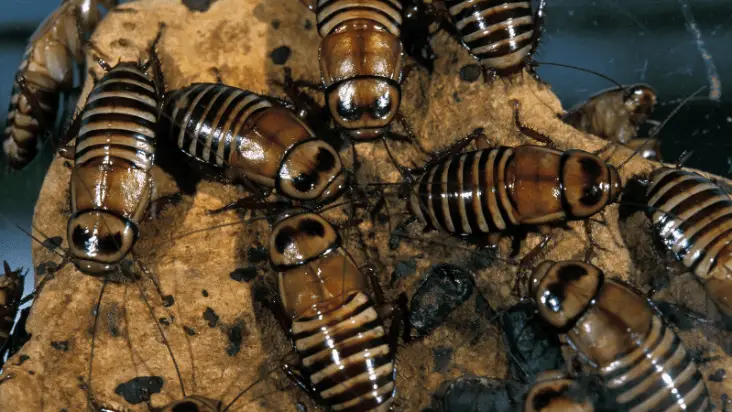
Create the perfect climate for your cockroaches
Cockroaches can’t regulate their own body temperature. And although they can survive for short extremes in temperature, a stable climate in the enclosure is desirable. Most cockroaches can best be kept with a temperature between 20°C and 25°C (68°F-77°F), which means you keep them slightly warmer than room temperature.
Some additional heating is preferable. They like a heat source in their enclosure to warm up their bodies. It also increases the visibility of your cockroaches. The way you should heat the enclosure is by using a simple light bulb above the enclosure. The wattage you should use depends on the size of the enclosure. Small enclosures can be already heated with a 15W light bulb, whereas bigger enclosures should be heated with 25W to 40W light bulbs.
You can adjust the height of the lamp to create the perfect temperature in the enclosure. Always place the lamp outside the enclosure. Cockroaches are attracted to the heat sources and when the lamp is inside the enclosure will sit onto the lamp with the risk of burning themselves.
You could use a heat mat to create a good temperature, but the downside is that when placed beneath the enclosure will dry out the substrate. Besides that, cockroaches will dig in the substrate to find some coolness. With a heat mat, the substrate is warmer than above. Cockroaches will keep digging to find a cool spot but won’t find any. Better to place the heat mat on the back of the enclosure. On top of the enclosure doesn’t make any sense, because warm air will rise, not heating the actual enclosure.
Cockroaches like to have a mildly humid environment. They can perfectly be kept in an enclosure with a humidity of around 40% to 60%, but it is better to keep them on the higher end. However, don’t make it too moist (or completely wet). Their exoskeleton will soften and can be damaged. You can increase the humidity by mildly spray some water in the enclosure. But make sure you don’t overdo it.
You can keep them in a 12h:12h day/night cycle. Cockroaches prefer darkness over light. The heat lamp can also be used to provide light. If you like to see your cockroaches more often during the day, time your heat lamp early in the morning for 8 hours so the mid-day and evenings you see your cockroaches crawl around. It also depends on the species of cockroach. Some like light (mostly a heat spot) more than others. Just experiment with it to see what your colony likes most.
Cockroach best feeding practice
I just recently wrote a complete guide on how to feed dubia roaches. The matter of fact is that all roaches kept as pets can be fed in the same way. However, there are some differences in what you feed them and what they prefer.
Cockroaches are scavenger which mainly eats plant materials, although they can survive on almost anything. As a pet, you can feed them a variety of leafy vegetables, fruits, cats or dogs pellets. or commercial complete diets for cockroaches. Yes, there are complete feeders made for cockroaches. It is best to feed them a variety of different products so they have a complete diet with all vitamins and minerals to keep them happy and healthy.
Here is a list of suitable products of almost any cockroach species:
- Apples
- Bananas
- Berries
- Oranges
- Pears
- Carrots
- Cucumber
- Collared greens
- Spinach
- Kale
- Sweet potatoes
- Beets
- Brocolli
- Squash
- Bee pollen
- Alfalfa (meal)
- Cat pellets
- Dog pellets
- Fish food flakes
- Complete cockroach feeder
Cockroaches seem to have preferences for orange food. Carrots and oranges are almost always accepted. However, don’t feed them only one product and experiment with what your colony also likes. Proper and fresh foods keep your cockroaches healthy, happy, makes them live longer and they will better reproduce. The offspring will also be healthier.
Feed your cockroaches daily with fresh foods. Remove uneaten food after 24 hours because vegetables and fruits can quickly start moulding. You can place the food on the substrate or place the food in a low-edged feeding bowl.
What about hydrating your cockroaches? You don’t need to provide them with water. They will get all the moisture needed from the fresh fruits and vegetables. Especially when you give them cucumber, endive, apples and oranges. These products have enough water to keep your cockroaches hydrated.
Can you play with a pet cockroach? Well, you can’t really play with it like you can with a cat or dog. However, especially the larger cockroach species, like the Madagascar Hissing Cockroach, are very suitable to handle and you can let them walk on your hand. Be gentle when picking up. Best to let the roach walk on your hand by itself, by gently pushing it in the right direction.
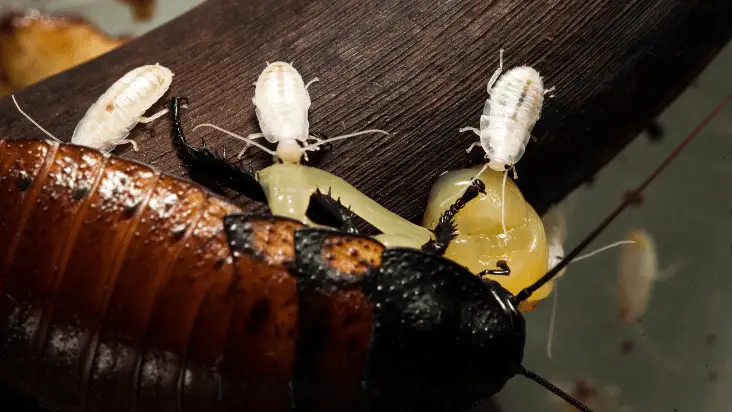
Breeding with your cockroaches
If you have males and females together and keep them in an enclosure that has a proper climate, you will quickly see young cockroaches crawling around. You don’t need to do much effort to breed with most cockroach species. As a matter of fact, you probably will have too much offspring sooner than that they won’t breed.
As long as you provide them with a good layer of substrate and feed them a variety of food breeding won’t be an issue. Is your colony growing too quick? Remove some females or separate the sexes so that your enclosure won’t overcrowd.
Be aware that when you have too many cockroaches, you can’t release them into the wild. There is a real chance they survive, become a pest and will pollute or destroy the natural environment. It is also against the law to release exotic animals into nature.
If you have too many animals, you can try to sell them to other pet lovers. There are many websites you can sell exotic pets, or you can contact the local pet shop. If you can’t get off your cockroaches and you need to get rid of them, keep them cooler or ultimately freeze them, or feed them to other animals like reptiles.
Other bugs you can keep as a pet
Although cockroaches are amazing pets, many other bugs make great pets too. Check out the bugs below; maybe you find them even more interesting to keep. One for one, they are great animals to keep at home.
– Praying mantises
– Stick insects
– Millipedes
– Beetles
– Ant colony
– Tarantulas
Share this page!

